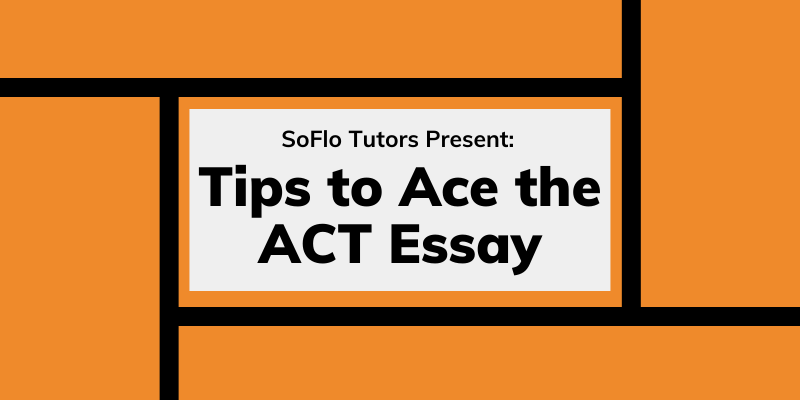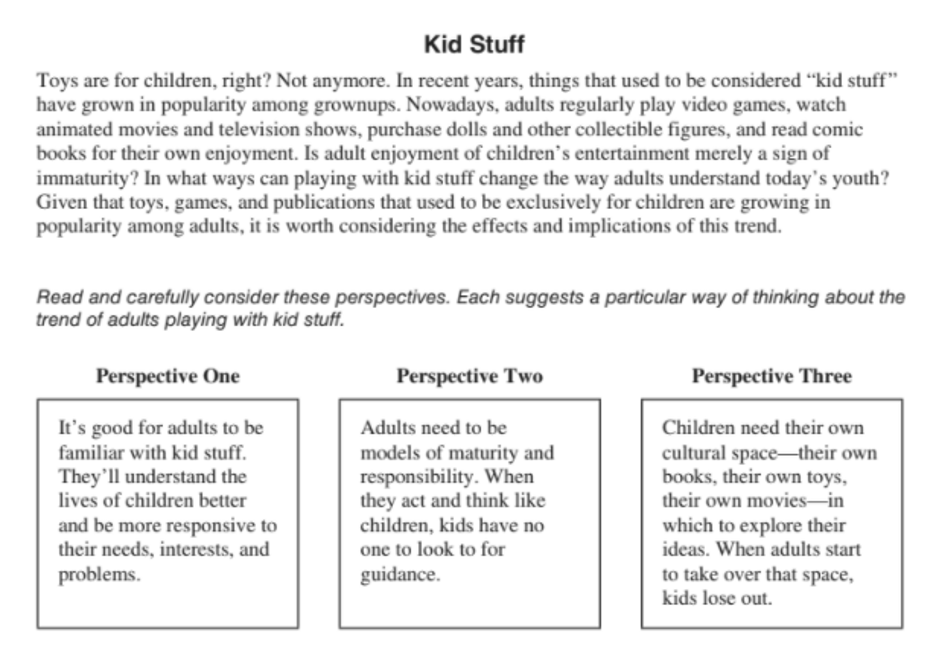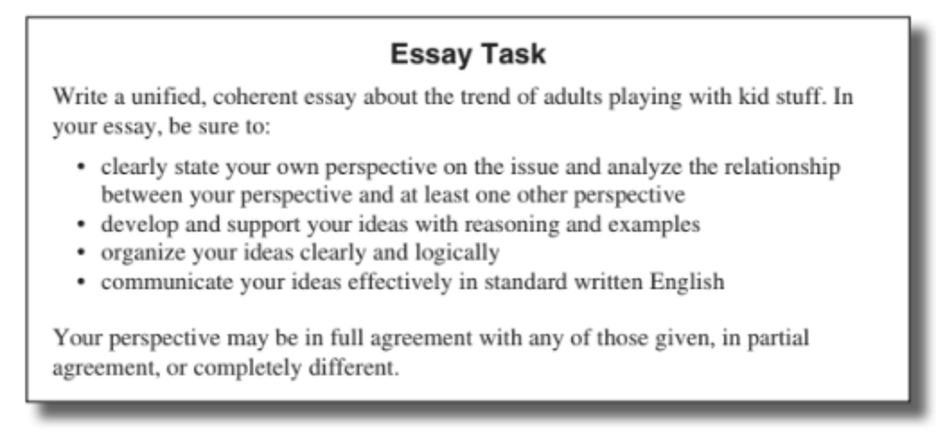
Tips for ACT Writing You Need to Know
Immediately after the other sections of the ACT, students can take the optional ACT Writing Test. This essay section is offered after the ACT on all national testing dates in the USA.
The writing test measures students’ writing skills and complements the English and reading tests of the ACT. Students are giving a writing prompt that describes a complex issue as well as three different perspectives on that issue. For example, take a look at the prompt below.

They must then develop their own perspective on the issue, which may adopt one or more of the presented perspectives. The point of view that students take will not affect the score, but whether they successfully address all parts of the essay task. The essay task never changes. All that is different is what comes after “Write a unified, coherent essay about…” as seen below.

Is The Essay Section Compulsory?
While the essay section is not compulsory, students cannot take the ACT Writing Test on its own – it must be taken in the same session as the required sections of the ACT (English, Math, Reading, Science). To do this optional section, students must account for an additional $15 and 45 minutes of essay writing.
Most colleges and universities do not require ACT Writing, including all the Ivy Leagues and several top public colleges such as the University of Michigan and the University of California schools. In fact, many schools have stopped requiring test scores altogether. Yet, many schools continue to recommend submitting these scores, including Emerson College, Rutgers, and UMass Boston.
A strong Writing score is the same as any other impressive test score. Students’ colleges may not require them, but strong scores will never hurt their chances. These scores can enhance students’ applications, and in fact, are still required at a handful of schools. Students may take this section to keep all options open when it is time to apply and to give themselves an edge in the admissions process.
Main Components of A Successful Essay
Keep in mind, the Writing Test is also scored differently and does not affect the composite ACT score (out of 36). Two trained readers manually score the essay in four different areas using the standards established by the ACT Writing rubric. The four domains are Ideas and Analysis, Development and Support, Organization, and Language Use and Conventions.
First, each reader assigns the essay a score from 1-6 for each of the four domains. Both readers’ scores for each domain are then added to give the student a score from 2-12 in each of the four domains. By averaging the four subscores, a single overall score is also calculated. When the readers’ individual scores differ by more than a point (rare), a third reader also evaluates the essay. This process may look something like this:
| Ideas and Analysis | Development and Support | Organization | Language Use and Conventions | ||
| Reader 1 | 4 | 3 | 4 | 5 | |
| Reader 2 | 3 | 4 | 3 | 4 | |
| Final Score | 7 | 6 | 7 | 9 | Overall: 7 |
In total, students receive five scores for this component of the ACT, one in each domain and a single overall score.
By developing the specific writing skills asked for in each of the four domains, students can write a strong and successful essay on the ACT. Let’s take a deeper look into each component.
| Subscore | What It Is | How to Score Big |
| Ideas and Analysis | Can the student come up with original ideas while building on and assessing those of others? | -Clear thesis -Complex ideas -Engage with 2 or more perspectives |
| Development and Support | Can the student support and integrate their ideas? | -Examples -Counterargument(s) -Connect claims to thesis |
| Organization | Can the student logically structure their ideas? | -Essay outline: intro, body (3+ paragraphs), conclusion -Topic sentences -Concluding sentences -Effective transitions |
| Language Use and Conventions | Can the student write clearly and concisely? | -Precise word choice -Varied style and sentence structure -Good grammar and punctuation |
Ideas and Analysis
This domain is concerned with the student’s ability to generate complex ideas and engage with multiple perspectives on the given issue. Students should:
- Develop a clear and focused thesis.
- Critically engage with two or more of the provided perspectives.
- Examine implications, complexities, assumptions, and tensions within the argument (rather than just agree or disagree with a perspective).
Development and Support
This domain is concerned with the student’s ability to discuss their ideas effectively through support, reasoning, and nuanced discussion of the argument. Students should:
- Provide relevant examples and reasoning to illustrate every claim.
- Integrate all their ideas by building onto them.
- Connect their claims to the thesis.
Organization
The domain is concerned with the student’s ability to strategically organize their ideas for clarity. Students should:
- Unify their ideas with a purpose and ensure logical progression of the argument, such as by including an introduction, body paragraphs, and a conclusion within the structure of the essay.
- Group information about the same idea(s) together within the same paragraph.
- Use effective transitions between paragraphs, such as through topic and concluding sentences that tie to preceding and succeeding ideas.
Language Use and Conventions
This domain is concerned with the student’s ability to use precise and clear language. Students should:
- Use proper grammar, spelling, and punctuation.
- Use specific language – avoid slang, abbreviations, and repetition.
- Vary sentence length and structure and be concise.
Students should familiarize themselves with the ACT Writing rubric to get a clear understanding of what the expectations are for their desired score.
Essay Development Step-by-Step
Like for any other section on the ACT, students can practice and learn the skills required to ace the ACT Writing Test. There are four steps in the essay writing process.
Pace Yourself
First, students must remember that this is a timed test. Students have 45 minutes to read the prompt, plan, write, and proofread their essay. We recommend that students take the first 5-10 minutes to read the prompt and plan their essay, the next 30-35 to write, and the couple minutes in the end to proofread. Not all testing locations may have an easily visible clock/timer, so we recommend that students keep a wristwatch on them.
To compose a well-written essay in the provided time, students will have to practice writing timed essays before they sit down for the test. Even students who ace their school essays are sometimes surprised by how fast 45 minutes go by.
With practice and patience, however, students can optimize their writing skills for the ACT. We recommend students set aside 45-minute practice sessions in the weeks leading up to the exam to answer ACT Writing prompts. Students must keep in mind, however, that they must practice at a consistent pace. That means, crunching four hours of essay writing the night before the test, or taking one practice test twice in two months will not work.
Yet, there is no singular pace that works for all students either. For some, practicing three times a week works, while for others, just once a week. Students should work by themselves, as well as with their parents, tutors, and teachers to determine what pace is most suitable for them and will help them achieve their best results.
Eight sample ACT Writing prompts from previous test years can be found here, on PrepScholar’s blog.
Planning
Once a student has mentally prepared themselves for the pace of the test, the planning process begins immediately as the student reads the prompt. During the planning part of the writing process, students should:
- Brainstorm ideas
- Generate their perspective on the issue
- Build a rough outline of their essay
Because the prompt in the ACT is so thorough, often, students may feel there is not much else to be said on the issue. Other students, however, may have several ideas and opinions but struggle to integrate them. To develop effective ideas, students should practice active reading. One approach to this is, while reading, to annotate the text with ideas such as the following:
- Connections (personal, cultural, social, political, etc.)
- Opinions
- Agreements
- Disagreements
- Criticisms
- Examples
After reading and annotating the essay prompt, students should solidify their perspective on the presented issue. Their perspective may be in no, partial, or full agreement with any one or more of the presented perspectives.
Students can practice generating perspectives for essay writing by considering each perspective’s strengths and weaknesses. A pro and con list may be useful for this. Then, students can brainstorm concrete examples that can be used to refute or support each perspective. Students can then pick a perspective, generate their own, or combine more than one based on where they can think of the most convincing examples and supporting evidence. This perspective must eventually be communicated explicitly in the thesis statement. A strong thesis statement includes the central argument of the essay – something that is debatable. It is also narrow or focused, and generally gives the reader a sense of how the essay will proceed.
Example of a non-argumentative thesis statement:
Some adults like to engage with kid stuff.
Example of a broad thesis statement:
Toys and comics are beneficial.
Example of an argumentative, focused thesis statement:
Adults engaging with “kid stuff” is beneficial for both adults and kids as it enables adults to have healthy pastimes and empathize better with children.
Once students have brainstormed their perspectives on the issue, they can develop an essay outline. Through this outline, students can organize and logically structure their essays. At SoFlo, we have seen two approaches as especially common and useful among students. The first, thesis to body, starts by planning the thesis statement and then the body, while the other, body to thesis, focuses on planning the body first and finally the thesis.
Students can begin by articulating a coherent thesis that and gives the reader the student’s perspective on the issue through a debatable and focused statement. Then, they can group their supporting ideas into two or three body paragraphs. The thesis statement can set a clear “roadmap” for the essay when written in the below format:
[Central perspective] because [argument A], [argument B], and [argument C].
Following the same order of arguments as in the thesis, students can dedicate a body paragraph to each argument. However, strong thesis statements need not follow this format, as long as they are debatable and focused, and answer the prompt. Also, during this time, students should plan where in their essay they will engage with the provided perspectives. Using bullet points to organize ideas into paragraphs is sufficient during the planning process. Students should not use up their limited time writing full sentences within a rough outline. However, the thesis statement should be written as a full sentence at this stage, as it will help guide the rest of the outline and essay. For example, the planning process may look something like this on paper:
| Thesis: Adults engaging with “kid stuff” is beneficial for both adults and kids as it enables adults to have healthy pastimes and empathize better with children. Body 1: Healthy pastimes -Emotional development -Stress reduction -Good role models (Counter Perspective 2) Body 2: Empathy -Perspective 1 -Connecting with children -Cultural awareness Body 3: Counterargument -Counter Perspective 3 |
The other common approach is to work backward, from the body to thesis. In other words, students can first brainstorm by writing down all their relevant ideas (again, using bullet points). Then, students can group similar ideas together into body paragraphs as in the example provided above. Finally, based on the grouped ideas, students can build a thesis statement that coherently ties together the central argument within those ideas.
With both approaches, students can build an effective outline for their essays.
Writing
By planning effectively, writing becomes easy. Students can use their annotations, pro/con lists, and outlines to write the essay. Strong essays include all the following:
- Introduction, including thesis statement
- Body paragraphs, including counterargument(s)
- Conclusion
The primary focus is on the body paragraphs, however. The introduction and conclusion can be as short as 2-3 sentences each. Let’s take a deeper look into various components of the written essay.
Introduction
Starting the essay may seem like the most daunting part to many students. Usually, essays begin with a hook – something to interest the reader. While a hook will give a student’s essay a strong start, it is not necessary, but rather a stylistic choice. Students should not spend too much time trying to think of an interesting quote or question to begin their essay. The main purpose of an introduction is to situate the reader. That means, students should include relevant context that leads into the thesis statement in their introduction. Placing the thesis statement at the end of the introduction makes it especially clear and easier for the reader to note the argument.
Body paragraphs
Each body paragraph must start with a topic sentence that defines its main point. Focusing on one point in one paragraph ensures clarity and structure.
Students must provide evidence and, where possible, examples for each of their points. In each body paragraph, students should also explain how the point connects to the central argument of the thesis.
By ending each paragraph with a concluding sentence that relates effectively with the next paragraph’s topic sentence, students can transition smoothly from one point to another.
To further support their arguments, students can dedicate one body paragraph to refuting an opposing view. In doing so, students will make a counterargument against a claim. This paragraph, however, is no different structurally. It should begin with a topic sentence that states the claim and its counterargument.
Alternatively, students may include counterarguments within their other body paragraphs, instead of dedicating one paragraph to refutation. If the student’s main point in a paragraph effectively refutes another claim, the student can include that particular counterargument within the same paragraph. But again, to not stray off subject, students should consistently reference their topic sentences and thesis statement to guide their writing.
Conclusion
The conclusion summarizes the argument (sometimes by restating the thesis with different wording) and provides its final significance – something to leave the reader with. This paragraph can be short and should not introduce any new ideas or arguments.
Proofreading
Ideally, students should leave a couple minutes at the end to proofread their essay. This is the opportunity to ensure that the essay is free of spelling errors and grammatical mistakes. Students should also ensure that all their ideas flow together. If something does not seem coherent during this read-through, or if ideas don’t logically integrate with each other, students may add transitions. Transitions may be transitory words/phrases such as although, though, on the other hand, similarly, despite this, or they may be intermediary sentences to connect one idea with another.
10 ACT Essay Tips to Crush the Test
SoFlo tutors often provide the following tips to their students, and together, tutors and students develop the needed skills in personalized one-on-one sessions.
Dear students:
To maximize success on the ACT Writing Test, the practice must begin before test day! Follow these tips to maximize your potential in essay writing:
- Read and write as much as possible.
- Taking timed essay tests is not always the most exciting thing. Luckily, this is not the only way to practice for the Writing Test.
- Read regularly – novels, short stories, articles, magazines, etc. By reading regularly, you will learn new ways of communicating through writing, which will help you be creative and effective in your own essays.
- Write as much as you can – journals, blog posts, stories, essays, etc. As the old saying goes: practice makes perfect.
- Become familiar with current issues and develop your own opinions.
- Providing relevant examples to support your arguments is a crucial part of the test. Staying informed will help you broaden your mental bank of real-life examples to connect to.
- Literature on current issues is saturated with opinions and critical analyses. Not only will learning about the world around you benefit you in your personal and professional life, but it will also teach you how to formulate informed opinions.
- Practice different writing formats.
- Playing with language is one of the best ways to learn to control it. Try writing more than just your required school essays. Keep a journal. Write poetry. Maybe also blog posts, speeches, and opinion pieces.
- Choose the side you can defend best and clearly define it.
- When practicing with ACT prompts, consider developing a strengths/weaknesses or pros/cons list for each of the presented perspectives. On paper, you can easily see which side you are able to best support and analyze.
- Be explicit about your perspective in your thesis statement. Your main argument should be easy to find and understand.
- Go long.
- ACT graders tend to reward longer essays. Write concisely but develop all your ideas thoroughly.
- Aim for at least three body paragraphs. Remember, the introduction and conclusion each need not be more than 2-3 sentences.
- Don’t be afraid to show off your language skills.
- You may not have a thesaurus with you on the test (and probably for the best), but that does not mean you should hesitate to use “meticulous” instead of “careful.”
- At the same time, if you remember a word but are not sure of its meaning, avoid using it. Be precise with your word choice and don’t let doubt prevent you from communicating your ideas effectively.
- Use concrete examples.
- Use specific examples to support your arguments.
- Explain how the provided example illustrates your point – don’t assume the reader has made the connection. However, with logical order in your writing and effective use of transitions, you may not have to explain. If it’s clear from the preceding sentences what you are exemplifying and why it is relevant, you’ve illustrated your point.
- Don’t forget counterclaims.
- To argue one side of the argument well, the other side(s) of the argument must be understood. Effectively addressing counterclaims shows the reader that you have thought deeply and critically about all sides of the argument.
- You can dedicate a body paragraph to a counterargument, or you can consider counterclaims to your main points within those same paragraphs.
- Use transition words between ideas and paragraphs.
- Handwriting matters.
- You may have written one of the most sophisticated and complex essays, but it will not matter if the reader cannot decipher your handwriting. When practicing for the ACT, always write on paper and avoid writing on your gadgets.
- Even if you have good penmanship, today, we are used to writing mainly through the keyboards on our phones and computers. Practice writing full essays to train your hand to move.
Ready, set, pen!










